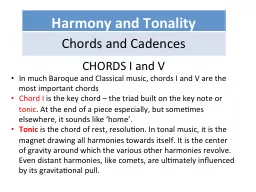

Chords and Cadences CHORDS I and V In much Baroque and Classical music chords I and V are the most important chords Chord I is the key chord the triad built on the key note or tonic ID: 511152
Download Presentation The PPT/PDF document "Harmony and Tonality" is the property of its rightful owner. Permission is granted to download and print the materials on this web site for personal, non-commercial use only, and to display it on your personal computer provided you do not modify the materials and that you retain all copyright notices contained in the materials. By downloading content from our website, you accept the terms of this agreement.
Slide1
Harmony and TonalityChords and Cadences
CHORDS I and V
In
much Baroque and Classical music, chords I and V are
the most important chords
Chord
I
is the key chord – the triad built on the key note or
tonic
. At the end of a piece especially, but
sometimes elsewhere
, it sounds like ‘home’.
Tonic
is the chord of rest, resolution. In tonal music, it is the magnet drawing all harmonies towards itself. It is the center of gravity around which the various other harmonies revolve. Even distant harmonies, like comets, are ultimately influenced by its gravitational pull
.Slide2
Harmony and TonalityChords and Cadences
CHORD V
Dominant
is the chord of dynamic stress. In common practice harmony, it is the chord that requires resolution. Chord V sounds less settled and complete – partly because it contains the leading note, a ‘tendency note’ that wants to rise to the tonic.Slide3
the intro of “I Want To Hold Your Hand” by the Beatles. It starts with a C to D sequence back and forth… then holding the D…. then FINALLY, when the verse begins, your ears are happy, and guess what… it’s chord I (the song is in G major, so naturally, G begins the verse).Slide4
Perfect Cadence
Perfect and imperfect cadences together account for the great majority of cadences in
music.
Cadence
Characteristics
Perfect
This is the most final sounding cadence and is often used at the end
of a piece of music.
It moves from
chord V to chord I
CadencesCadences work like punctuation. They help the listener understand what is going on in the musicSlide5
Perfect Examples of Perfect CadencesI wanna hold your hand – starts with a C to D sequence back and forth… then holding the D ….then FINALLY the verse begins, your ears are happy and guess what… it’s a chord I (G major)Soul Mate by No use for a Name
– 0.35-0.37 seconds ‘Stuck by your side since you were born’ (
Eb
to Ab) and then 1:37-1.39 (Db, Eb to Ab)Slide6
Imperfect Cadence
Imperfect
This cadence sounds incomplete because it
does not finish on the
tonic. There is a strong unfinished urge and a desire to move to the
tonic chord after an imperfect cadence.
It moves from any chord to chord V.
It
propels the piece forward
CadenceCharacteristics
Perfect and imperfect cadences together account for the great majority of cadences in music whose
tonality is
functional.